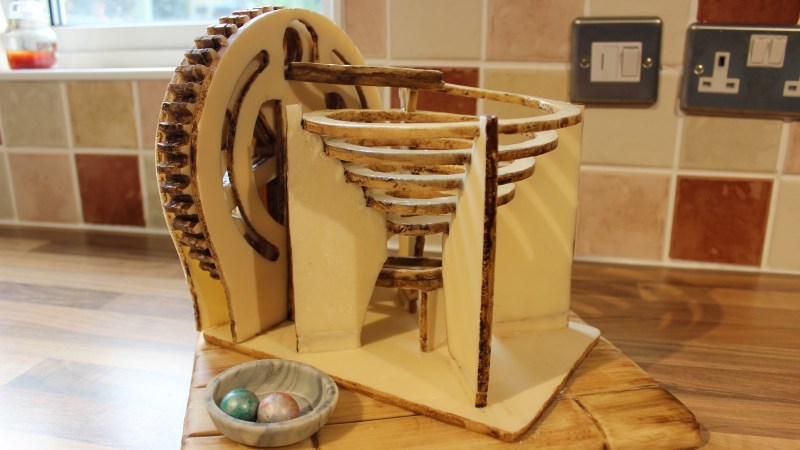Prolific creator [Martin Raynsford] recently created a plus-sized edible version of his laser-cut Marble Machine for a Cake International exhibit and competition; it seemed simple to do at first but had quite a few gotchas waiting, and required some clever problem-solving.

The original idea was to assemble laser-cut gingerbread parts to make the machine. Gingerbread can be laser-cut quite well, and at first all seemed to be going perfectly well for [Martin]. However, after a few days the gingerbread was sagging badly. Fiddling with the recipe and the baking was to no avail, and it was clear [Martin] needed to find something other than gingerbread to work with. After experimenting, he settled on a modified sugar paste which kept its shape and dried hard enough to work with. (While appearing to stretch most people’s definition of “cake” past the breaking point, the category [Martin] entered in the competition allows it.) The parts were cut by hand using laser-cut wood parts as a guide, then finished in a food dehydrator overnight.
The next problem was how to create the large spiral which forms the main ramp. The answer was to laser-cut a custom support structure that supported the piece while it dried out, and doubled as a way to transport the piece safely. High stress points got extra layers cemented with sugar glue, and some parts were reinforced internally with strands of uncooked spaghetti. Everything was sealed with an edible shine, which [Martin] says acts as a kind of varnish for cakes. A video demonstration is embedded below.
It’s nice to see the work paid off, especially since the first version (with gingerbread) was close but ultimately proved to be a dead-end, and there were multiple other problems to overcome. We’re sure the Edible Marble Machine raised some eyebrows, though perhaps not quite as many as the also-edible-but-somewhat-bizarre Vin Diesel Ham Sandwich.
















gumballs instead of marbles would perhaps be a nice alternative (considering you can’t eat marbles but you can eat gumbals…) Very creative cake-idea, I’m sure the creator get’s full points for originality.
Very fun project!
They used gobstopper / jaw breaker candies with a coat ofmetallic food paint.
ahh.. ok, that makes more sense then marbles. Thanks for the info.
Hard candy rods, a true candy cane lane, would probably work here too, though you’d need significant skill or complex jigs to shape the track.
Cast gears might work better too, with corn starch dry lube to prevent siezing.
Curious if something like oatmeal or other fibers or plant matter mixed into the gingerbread would have acted similarly to fiberglass reinforcement? Or if the gingerbread just didn’t have enough overall strength and cohesion? Gingerbread tends to be solid right up until it catastrophically breaks, similar to carbon fiber. Not that fiberglass is edible but is there an edible equivalent that might work?
I’m not sure it’d add much strength, but you could ‘laminate’ layers of cotton candy with ginger bread sheets. Maybe add something to the cotton candy to increase its strength.
Are there any ferromagnetic or conductive candies? If so, One could power this machine with a motor!
Food grade graphite or gold/silver leaf ought to do the job.
Not quite sure that would work quite how you would want it to.
Never know till it’s tried. Now then, any volunteers for the edible micro controller?
Okay, who started thinking of ? ….
https://www.eater.com/2010/8/3/6724399/heston-blumenthal-parodied-on-the-it-crowd
I suspect the problem with the gingerbread is that it absorbs moisture from the air and goes soggy/saggy. Keep it perfectly dehydrated and it will probably be fine, but put it out in “normal outside air” and it’ll go soft. Same as with any sort of biscuit really.